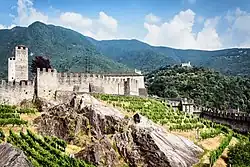Swiss wine
Swiss wine is produced from nearly 15,000 hectares (37,000 acres) of vineyards, and the wines are mainly produced in the west and in the south of Switzerland, in the cantons of Geneva, Neuchâtel, Ticino, Valais and Vaud. White grape varieties are grown on 43% of the country's vineyard area, and red grape varieties on 57%.[1]
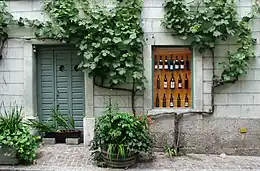
According to the Swiss Federal Office of Agriculture, Swiss wine production in 2019 was just over 979,445 hectolitres (25,874,200 US gal; 21,544,800 imp gal), almost equal amounts red and white.[1]
Nearly all the national production is drunk within the national boundaries;[2] less than 2% of the wine is exported (mainly to Germany). For example, in 2019, only 13,193 hectolitres were exported.[1] Switzerland ranks in the top 10 of per capita consumption of wine,[2] and as of 1983 imported two thirds of it, including more Beaujolais than the United States.[3] In 2019, 1,784,371 hectolitres of wine consumed was imported, compared to 945,585 hectolitres of domestic wine consumed.[1]
History
The tradition of wine and viticulture in Switzerland is very old, beginning no later than the Roman era. Coming from the Mediterranean basin, viticulture was generally introduced from the 1st century AD, after integration into the Roman Empire. Ticino and Upper Valais are perhaps exceptions: it is possible that the cultivated vine (Vitis vinifera) was introduced from the Iron Age south of the Alps and that it then crossed the Alpine passes.[4]
The oldest recorded bottle, made in ceramic, was found near Sembrancher (Valais), in a Celtic tomb of a lady of 2nd century BC. An inscription on the bottle indicates that it contained wine. Around the 150s BC, in the Celtic era, the people in Valais offered wine to the dead, and probably they also drank the same wine. After a century, the Roman amphorae also appeared.
Vineyards became an integral part of the Swiss landscape. The most extensive terraced vineyards are found in Valais and Lavaux.
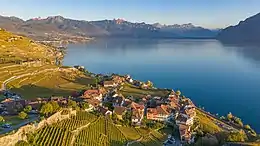 Vineyards of Lavaux |
 Vineyards of Valais |
Geography and climate
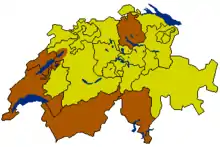
Six wine regions are defined by Swiss Wine Promotion, an association that represents Swiss winemakers.[5] They are: Geneva, German-speaking Switzerland, Three Lakes (including Neuchatel, Fribourg, and part of the canton of Bern), Ticino, Vaud, and Valais.[6]
Switzerland is a fairly small country with great diversity in climate and soils due to the Alps. Ticino, on the southern side, has a sunnier climate more influenced by the Mediterranean, while the rest of the country, being on the north side, are more affected by weather coming off the Atlantic Ocean.[7] Contrary to northern Switzerland, there is also a tradition of olive oil-making in Ticino, possibly also since the Roman Era.[8]
Grape varieties

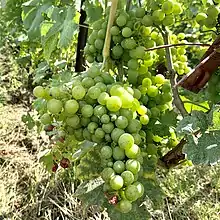
The two most common grape varieties in Switzerland are the red Pinot noir at around 30% and the white Chasselas at around 27%. A large number of grape varieties are cultivated in Switzerland, many of them indigenous or regional specialties. Some 90 grape varieties are cultivated on an area of 1 hectare (2.5 acres) or more.[9]
Common grape varieties in Switzerland (2009, all varieties greater than 50 ha)[9] Variety Color Synonym(s) Area (%) Area (ha) Pinot noir red Blauburgunder 29.7 4402 Chasselas white Gutedel 27.1 4013 Gamay red 10.2 1514 Merlot red 6.9 1028 Müller-Thurgau white 3.3 493 Gamaret red 2.6 380 Chardonnay white 2.2 321 Sylvaner white Rhin 1.6 241 Pinot gris white Malvoisie 1.5 216 Garanoir red 1.4 203 Syrah red 1.2 181 Petite Arvine white 1.0 154 Sauvignon blanc white 0.9 134 Humagne rouge red 0.9 128 Cornalin red Landroter 0.8 116 Diolinoir red 0.8 112 Pinot blanc white 0.7 105 Savagnin blanc white Heida 0.6 83 Cabernet Sauvignon red 0.4 63 Cabernet Franc red 0.4 54 All white varieties 42.1 6245 All red varieties 57.9 8574 Grand total 100.0 14820
Other grapes grown in Switzerland include hybrid varieties like Muscat bleu which had 3 hectares (7.4 acres) in cultivation for commercial winemaking 2009.[10]
Classification
For a long time, Switzerland lacked detailed national regulations regarding wine classification, which meant that it was to a large extent up to wine producers about what to put on wine labels; neither a German wine-style Prädikat system nor a French wine-style appellation system was implemented, and as a non-EU member, Switzerland did not have to implement European Union wine regulations.[11] Wines were usually labelled by their village of origin, by grape variety, or using a brand name. From the late 1980s, though, a French-style Appellation d'Origine Contrôlée system started to be implemented, starting with the Canton of Geneva. These regulations are mainly implemented by the cantons themselves.

Wine styles
Over the years, the Swiss have developed a number of unique specialty wines from grapes rarely found outside Switzerland. These include:
- Vin des glaciers—a sherry-style wine that utilizes a solera system of wine stored in larch wood or oak barrels that are never fully emptied with newer vintages being added to the barrels containing the older vintages.[12] The wines are primarily made from the Swiss wine grape Rèze in Valais canton.[13]
See also
References
- "Das Weinjahr 2019" (PDF). Bundesamt für Landwirtschaft BLW. Bundesamt für Landwirtschaft BLW (Federal Office for Agriculture FOAG). 2020-04-30. Retrieved 2021-03-07.
- Brostrom, Geralyn G.; Brostrom, Jack (2008-12-30). The Business of Wine: An Encyclopedia: An Encyclopedia. ABC-CLIO. pp. 234–. ISBN 9780313354014. Retrieved 7 May 2013.
- McPhee, John (1983-10-31). "La Place de la Concorde Suisse-I". The New Yorker. p. 50. Retrieved 22 July 2013.
- "Viticulture". Historical Dictionary of Switzerland. Retrieved 27 January 2023.
Venues du bassin méditerranéen, la viticulture et la viniculture ont généralement été introduites en Suisse à partir du Ier s. apr. J.-C., après l'intégration dans l'Empire romain. Le Tessin et le Haut-Valais font peut-être exception: il se peut que la vigne cultivée (Vitis vinifera) ait été introduite dès l'âge du Fer au sud des Alpes et qu'elle ait alors franchi les cols.
- swisswine (2016-01-01). "Swiss Wine - Who are we ?". Swiss Wine. Archived from the original on 2020-11-26. Retrieved 2021-03-09.
- Wine regions and wines: Switzerland (PDF), Swiss Wine Promotion, archived from the original (PDF) on 2020-12-01
- "The Climate of Switzerland - MeteoSwiss". www.meteoswiss.admin.ch. Retrieved 2021-03-09.
- "Olio d'oliva ticinese". Culinary Heritage of Switzerland. Retrieved 9 March 2022.
Non si sa esattamente chi abbia portato l'albero di olivo in Ticino. Si crede che i legionari che avevano partecipato alle campagne galliche di Giulio Cesare, una volta in pensione, abbiano piantato degli olivi sul lago di Como. È possibile che si siano spostati anche più in là, verso il Ceresio, ma non è mai stato dimostrato. Tuttavia, il lago di Como e quello di Lugano sono molto vicini e a quei tempi non c'era un confine nazionale come al giorno d'oggi. È anche possibile che l'olivo sia stato selezionato partendo dagli olivi selvatici (oleastri).
- Office fédéral de l’agriculture OFAG: Das Weinjahr 2009 / L'année d'viticole 2009 Archived 2011-07-07 at the Wayback Machine.
- J. Robinson, J. Harding and J. Vouillamoz. Wine Grapes - A complete guide to 1,368 vine varieties, including their origins and flavours, p. 687, Allen Lane 2012 ISBN 978-1-846-14446-2.
- Jancis Robinson, ed. (2006). "Switzerland". Oxford Companion to Wine (Third ed.). Oxford: Oxford University Press. p. 671. ISBN 0-19-860990-6.
- My Switzerland "Vin des glaciers - Le "sherry" du Valais" Official Switzerland Tourism Site. Accessed: August 18th, 2012.
- J. Robinson. Jancis Robinson's Guide to Wine Grapes, p. 152, Oxford University Press 1996 ISBN 0198600984.
External links
- Documentary about Heroic Viticulture in Valais
- swisswine.ch, the trade organisation promoting Swiss Wines
